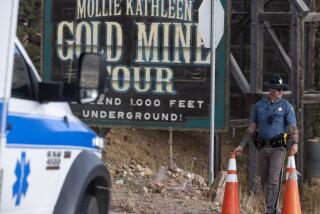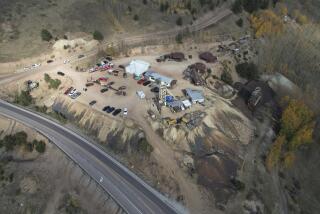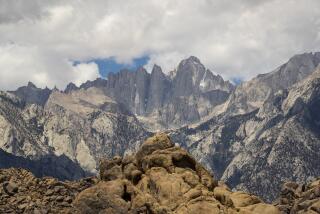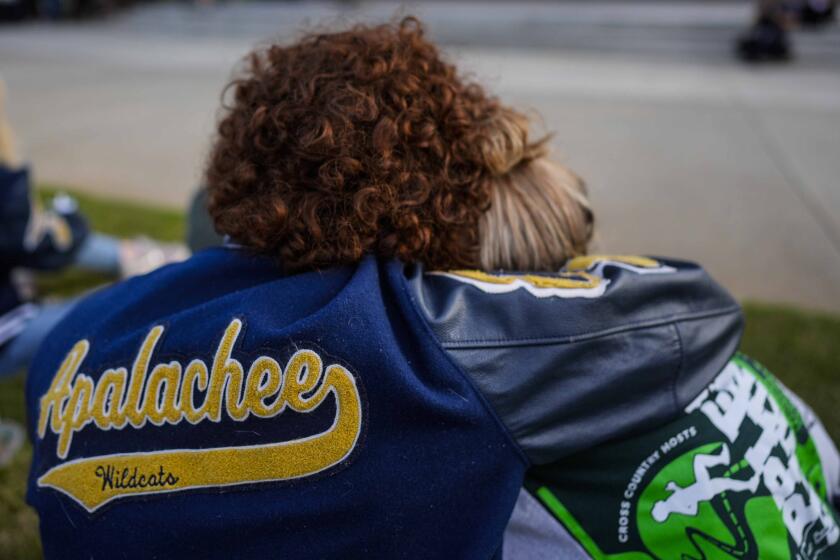Desperate effort to aid miners
HUNTINGTON, UTAH — Rescuers drilled and smashed through solid rock Monday in an attempt to reach six coal miners trapped deep underground by a massive predawn cave-in.
Searchers said they were within 1,700 feet of the miners but their initial approach failed. Workers could not contact the miners. Authorities were uncertain whether the men were still alive.
A top mining company official said the collapse was caused by an earthquake, but seismologists said they suspected the reverse.
Company officials and hundreds of workers at the Crandall Canyon Mine -- 140 miles south of Salt Lake City -- focused on trying to reach the six men, who were believed to be about 1,500 feet below the surface and 3.4 miles from the mine entrance.
Mine rescue teams from around Utah were arriving Monday night as other miners, exhausted and covered in black dust, promised to return after a few hours’ sleep. The rescue effort was to continue overnight.
The identities of the miners were not released.
About two dozen family members were in a one-story brick senior center guarded by sheriff’s deputies. The relatives, many of them red-eyed, sat on couches and nibbled snacks as the sun began to set in this arid patch of desert that makes up central Utah. Mining officials delivered regular updates.
“There’s nothing on my mind right now but getting those miners out,” said Robert E. Murray, chairman of Murray Energy Corp. of Cleveland, part owner of the mine. “All that is humanly possible is being done to gain access to these trapped miners,” said Murray, who flew to the mine within hours of the accident.
It might take several days to reach the men, who could have enough oxygen and water to survive, Murray said. Four other miners escaped.
The mining company recruited about 200 employees to join the rescue effort. A command center was set up in Huntington, a rural town of 2,000 about 15 miles from the mine entrance. Rescuers divided into four teams, each taking a different route to where the trapped workers were believed to be.
Murray said some rescuers were drilling vertically from the top of the mountain while others moved horizontally, using heavy machinery to break through solid rock. Murray said he was hoping rescuers could find an old mining shaft that would allow them to get within 100 feet of the miners.
“The idea is to get a hole into where they are,” Murray said. “They could be in a chamber 1,000 feet long or they could be dead.”
The Crandall Canyon Mine, in Emery County, burrows deep into a mountain in the Manti-La Sal National Forest, a sparsely populated area. The mine entrance is large enough to accommodate trucks that transport workers into the tunnels.
Federal safety inspectors have issued more than 320 citations to the mine since January 2004, including more than two dozen this year. The citations included inadequate ventilation and too few mine rescue teams. Mine owners have paid more than $150,000 in penalties.
Bruce Dial, who was a mining inspector for 24 years and is now a consultant based in North Carolina, said most of this year’s citations were for minor infractions. The mine, Dial said, had “a better safety record than many others.”
Murray said the mine had not had a serious accident in more than two decades. But the county is still haunted by a 1984 fire that killed 27 in the nearby Wilberg mine.
Percy Mounteer, 55, is a former miner and the owner of a popular hangout, the Star Grill. He was the radio dispatcher in the 1984 fire.
“If you can imagine what it’s like down there, like a lot of us, it’s even scarier,” he said. “It’s something you wouldn’t wish on your worst enemy.”
For much of Monday, townspeople wandered in and out of the Huntington diner trading news and consoling one another.
Mining, of course, has always been a dangerous occupation. This year, 30 miners -- 10 of them coal miners -- have been killed in the United States, according to the federal Mine Safety and Health Administration.
Mine rescue operations face the same perils.
“You don’t want to make the situation worse,” said John Baza, director of the Utah Division of Oil, Gas and Mining. Boring or blasting through rock, if done in the wrong place or time, could kill trapped miners. Baza characterized rescues as “incredibly complex.”
The cause of the cave-in was in dispute Monday.
Murray insisted that a 3.9-magnitude earthquake a mile from the mine had caused the collapse.
“Our active mining did not cause this earthquake a mile away,” he said. “How could our active mining a mile away cause an earthquake to happen a mile away?”
Seismologists at the University of Utah detected the quake about 2:40 a.m. and said data they had collected so far indicated the cave-in probably caused the tremors. Mine cave-ins have caused similar seismic waves in the West. But they said they could reach a definitive conclusion until all the evidence had been assessed, especially data from within the mine.
The company has long used a method called “retreat mining,” in which columns of coal hold up the ceiling. Once an area has been mined, the columns are mined too, then intentionally collapsed, closing off that section as the miners retreat.
But the company began using a more modern technique in the mid-1990s.
It’s unclear whether retreat mining is still used in some parts of the mine.
Utah was the 12th-largest producer of coal in the United States last year, and Emery County ranked second in the state in coal production.
janet.wilson@latimes.com
Powers reported from Utah, Wilson from Los Angeles. Times staff writers Lynn Marshall and Tomas Alex Tizon contributed to this report.
More to Read
Sign up for Essential California
The most important California stories and recommendations in your inbox every morning.
You may occasionally receive promotional content from the Los Angeles Times.










